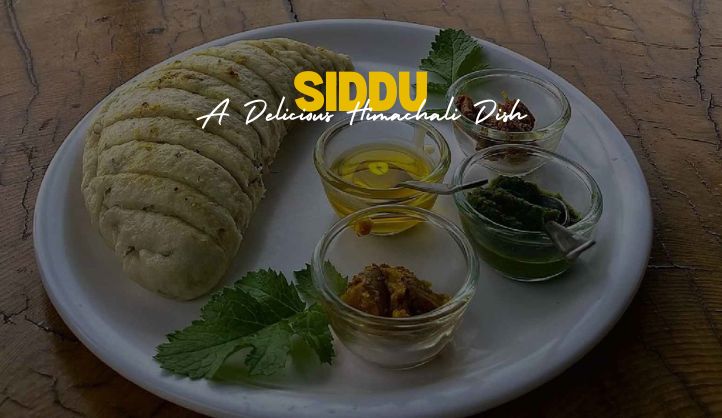Himachal Pradesh, a beautiful state in northern India, is not just famous for its snow-capped mountains and scenic valleys but also for its unique and delicious food. Among its many traditional dishes, Siddu stands out as a favorite. This steamed bread, stuffed with flavorful fillings, is a must-try for anyone visiting the region. In this blog, we’ll explore everything about Siddu—its origins, how it’s made, and why it’s so special in Himachali cuisine.
What is Siddu?
Siddu (also spelled as Siddu or Siddoo) is a traditional dish made from wheat flour. It is a type of steamed bread that is soft and fluffy on the inside but slightly firm on the outside. The dish is unique because of its method of preparation and its flavorful fillings, which can be either savory or sweet.
Siddu is usually served hot with ghee (clarified butter), chutney, or dal (lentil curry). The most common fillings include poppy seeds, walnuts, sesame seeds, green peas, and a mix of spices. It is not only delicious but also nutritious, making it a popular choice in the cold mountain regions.
The Origins of Siddu
The history of Siddu is deeply rooted in the culture and traditions of Himachal Pradesh. It is believed to have originated in the rural areas of the state, where people relied on simple, homemade food that could provide energy in the harsh mountain climate. The dish became popular because it uses locally available ingredients and is easy to prepare.
In the old days, Siddu was often made during special occasions, festivals, and family gatherings. Over time, it became a staple food, especially in the higher-altitude regions like Kullu, Manali, and Spiti Valley, where people needed hearty meals to stay warm and energized.
How is Siddu Made?
Making Siddu might seem simple, but it requires skill and patience. Here is a step-by-step explanation of how this delicious dish is prepared:
Ingredients Needed:
- For the Dough:
-
- Wheat flour
- Water
- Yeast (optional, for fluffiness)
- For the Filling:
- Poppy seeds (khus khus)
- Walnuts or cashews (optional)
- Sesame seeds
- Spices (like coriander, cumin, and chili powder)
- Green peas or spinach (optional)
- Salt and pepper
Preparation Process:
- Making the Dough:
- Start by mixing wheat flour with water to make a soft dough.
- Knead the dough well and let it rest for a few hours. Traditionally, yeast is added to help the dough rise, but it can also be made without it.
- Preparing the Filling:
- Roast the poppy seeds, walnuts, and sesame seeds lightly until aromatic.
- Grind the mixture into a coarse paste and add spices like salt, pepper, coriander, and cumin.
- If you want a vegetarian filling, cooked green peas or chopped spinach can be added.
- Stuffing the Dough:
- Divide the dough into small portions and flatten them into circles.
- Place a spoonful of filling in the center of each circle and fold it carefully, sealing the edges.
- Steaming the Siddu:
- Place the stuffed dough in a steamer and cook for about 15-20 minutes. The steaming process gives Siddu its soft texture and makes it easy to digest.
- Serving:
- Serve the hot Siddu with melted ghee, green chutney made from mint and coriander, or a bowl of dal.
Why is Siddu So Special?
This dish is more than just a food, it represents the simplicity and warmth of Himachali culture. Here’s why it holds a special place in the hearts of locals and visitors alike:
Nutritious and Filling:
The combination of wheat, nuts, and seeds makes the dish a highly nutritious dish. It is rich in energy, which is essential for people living in cold, mountainous regions.
Perfect for the Climate:
The warm, steamed bread provides comfort during the chilly weather of Himachal Pradesh.
Burst of Flavors:
The filling is packed with flavors, ranging from nutty to spicy, making every bite a delightful experience.
Cultural Significance:
Siddu is often made during festivals and special occasions, showcasing the culinary traditions of Himachal Pradesh.
Where Can You Try Siddu in Himachal Pradesh?
If you’re visiting Himachal Pradesh, here are some of the best places to try authentic Siddu:
Local Villages:
Small villages in Kullu, Manali, and Spiti Valley are the best places to experience homemade Siddu. Many locals prepare it using traditional methods, giving you an authentic taste.
Roadside Dhabas:
Roadside eateries, or dhabas, along the highways, often serve freshly made Siddu with a variety of accompaniments.
Himachali Restaurants:
Many restaurants in Shimla, Dharamshala, and Manali specialize in traditional Himachali food, including Siddu.
Homestays:
Staying at a homestay in Himachal Pradesh is a great way to enjoy home-cooked Siddu. Hosts often prepare it for guests, offering a warm and personalized dining experience.
How to Make Siddu at Home?
If you’re inspired to try making Siddu at home, you can easily recreate it with some practice. Just follow the steps mentioned above, and don’t forget to steam it properly for the best results. You can experiment with different fillings to suit your taste, such as cheese, potatoes, or even sweet options like jaggery and coconut.
Siddu in Modern Times
While Siddu remains a traditional dish, it has also found its way into modern kitchens. Many chefs and food enthusiasts are experimenting with Siddu by adding unique fillings and pairing them with new accompaniments. Despite these innovations, the essence of Siddu remains the same—a wholesome, comforting dish that reflects the heart of Himachal Pradesh.
Other Local Dishes of Himachal Pradesh
While Siddu is a star of Himachali cuisine, there are many other local dishes that showcase the rich and diverse flavors of the region. Here are some of them:
1. Dham
Dham is a traditional feast served during festivals and weddings in Himachal Pradesh. It consists of a variety of vegetarian dishes, such as rice, rajma (kidney beans), dal, boor ki kadi (gram flour curry), and sweet rice. These dishes are served on leaf plates, adding to the cultural authenticity. Dham is prepared by specialized cooks known as botis and is enjoyed as a communal meal.
2. Chana Madra
This creamy dish originates from the Chamba region. It is made with chickpeas cooked in a thick yogurt-based gravy flavored with spices like cinnamon, cardamom, and coriander. Chana Madra is often served with rice or roti and is a staple in many Himachali households.
3. Babru
Babru is a type of Himachali bread that resembles a stuffed puri. The dough is made from wheat flour and stuffed with a paste of black gram (urad dal). It is deep-fried until golden brown and usually served with tamarind chutney or aloo sabzi. Babru is a popular breakfast item and a must-try street food in Himachal Pradesh.
4. Tudkiya Bhath
This is a spiced rice dish from Himachal Pradesh, somewhat similar to biryani but unique in its preparation. Tudkiya Bhath is made with rice, lentils, yogurt, and a mix of local spices. Potatoes and tomatoes are often added to enhance its flavor. It is traditionally served with mash dal (a type of lentil curry).
5. Bhey
Bhey, also known as lotus stem curry, is a popular dish in Himachali cuisine. Sliced lotus stems are cooked with gram flour and spices to create a delicious and slightly crunchy curry. It is often served with steamed rice or chapati.
6. Chha Gosht
Chha Gosht is a non-vegetarian delicacy made with marinated lamb. The lamb is cooked in a spicy yogurt-based gravy flavored with cardamom, cinnamon, and red chili. This dish is commonly prepared during special occasions and is best enjoyed with rice or naan.
7. Patande
Often referred to as Himachali pancakes, Patande is a sweet dish made from a batter of wheat flour, sugar, and milk. The batter is poured into a hot pan and cooked until golden brown. These pancakes are usually served with honey or fresh cream, making them a delightful breakfast treat.
8. Aktori
Aktori is a festive dish prepared in the Lahaul and Spiti regions. It is made with buckwheat flour and resembles a pancake. Aktori is often made during local festivals and is served with ghee or butter.
9. Thukpa
Thukpa is a noodle soup made with a variety of vegetables, spices, and sometimes meat, such as chicken or mutton. The dish is hearty, warming, and perfect for the chilly weather of the Himalayas. Its flavorful broth, combined with noodles and fresh ingredients, makes it a comforting and satisfying meal.
10. Mittha
Mittha is a sweet rice dish that is flavored with jaggery, raisins, and dry fruits like almonds and cashews. It is often prepared during festivals and religious ceremonies. The sweetness of Mittha makes it a perfect dessert after a hearty Himachali meal.
Conclusion
Himachal Pradesh’s cuisine is a beautiful reflection of its rich culture and traditions. From the hearty Siddu to the festive Dham and the sweet Mittha, every dish tells a story of the region’s heritage. If you ever visit Himachal Pradesh, make sure to indulge in these local delicacies and experience the warmth and simplicity of its people through their food.
Whether you’re enjoying a plate of steaming hot Siddu or relishing the flavors of Chana Madra, one thing is certain—you’ll leave Himachal with a heart full of memories and a belly full of delicious food!
FAQs About Siddu
1. Is Siddu vegetarian?
Yes, Siddu is vegetarian. Its fillings include nuts, seeds, and spices.
2. Can I make Siddu without a steamer?
Yes, you can use a large pot with a steaming rack or a colander to steam the dish. Just ensure the lid is tightly closed to trap the steam.
3. What is the best accompaniment for Siddu?
Siddu is best enjoyed with ghee, green chutney, or dal. Some people also like it with a hot cup of tea.
4. How long does it take to make Siddu?
Preparing Siddu can take about 2-3 hours, including the time needed for the dough to rise.
5. Is Siddu available outside Himachal Pradesh?
While it is rare, some Himachali restaurants and food festivals in other parts of India may serve Siddu.





